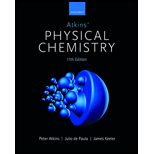
Concept explainers
Interpretation:
The polarizability and the dipole moment of fluorobenzene are to be calculated.
Concept introduction:
The dipole forces are attractive forces between two permanent dipoles. The interaction is between the positive end of one polar molecule and the negative end of another polar molecule. The induced dipole interaction occurs when an ion or a dipole induces a temporary dipole in an atom or a molecule with no dipole. The induced dipole forces are the attraction forces between molecules having temporary dipoles.
Answer to Problem 14A.5AE
The dipole moment of fluorobenzene is
The polarizability of fluorobenzene is
Explanation of Solution
The molar polarizations of fluorobenzene vapour are shown below.
(1)
(2)
The polarization
Therefore, the polarizability is calculated by the formula shown below.
In the given case, the polarizability remains constant and the polarization varies with respect to temperature. Therefore, the dipole moment is calculated by the formula shown below.
The value of
The value of Boltzmann constant is
The value of Avogadro’s number is
Now, Substitute the values of
Simplify the above equation.
The conversion of C m to Debye is done as shown below.
Therefore, the conversion of
Therefore, the dipole moment of fluorobenzene is
Substitute the value of
Therefore, the polarizability of fluorobenzene is
Want to see more full solutions like this?
Chapter 14 Solutions
Atkins' Physical Chemistry
 ChemistryChemistryISBN:9781305957404Author:Steven S. Zumdahl, Susan A. Zumdahl, Donald J. DeCostePublisher:Cengage Learning
ChemistryChemistryISBN:9781305957404Author:Steven S. Zumdahl, Susan A. Zumdahl, Donald J. DeCostePublisher:Cengage Learning ChemistryChemistryISBN:9781259911156Author:Raymond Chang Dr., Jason Overby ProfessorPublisher:McGraw-Hill Education
ChemistryChemistryISBN:9781259911156Author:Raymond Chang Dr., Jason Overby ProfessorPublisher:McGraw-Hill Education Principles of Instrumental AnalysisChemistryISBN:9781305577213Author:Douglas A. Skoog, F. James Holler, Stanley R. CrouchPublisher:Cengage Learning
Principles of Instrumental AnalysisChemistryISBN:9781305577213Author:Douglas A. Skoog, F. James Holler, Stanley R. CrouchPublisher:Cengage Learning Organic ChemistryChemistryISBN:9780078021558Author:Janice Gorzynski Smith Dr.Publisher:McGraw-Hill Education
Organic ChemistryChemistryISBN:9780078021558Author:Janice Gorzynski Smith Dr.Publisher:McGraw-Hill Education Chemistry: Principles and ReactionsChemistryISBN:9781305079373Author:William L. Masterton, Cecile N. HurleyPublisher:Cengage Learning
Chemistry: Principles and ReactionsChemistryISBN:9781305079373Author:William L. Masterton, Cecile N. HurleyPublisher:Cengage Learning Elementary Principles of Chemical Processes, Bind...ChemistryISBN:9781118431221Author:Richard M. Felder, Ronald W. Rousseau, Lisa G. BullardPublisher:WILEY
Elementary Principles of Chemical Processes, Bind...ChemistryISBN:9781118431221Author:Richard M. Felder, Ronald W. Rousseau, Lisa G. BullardPublisher:WILEY





